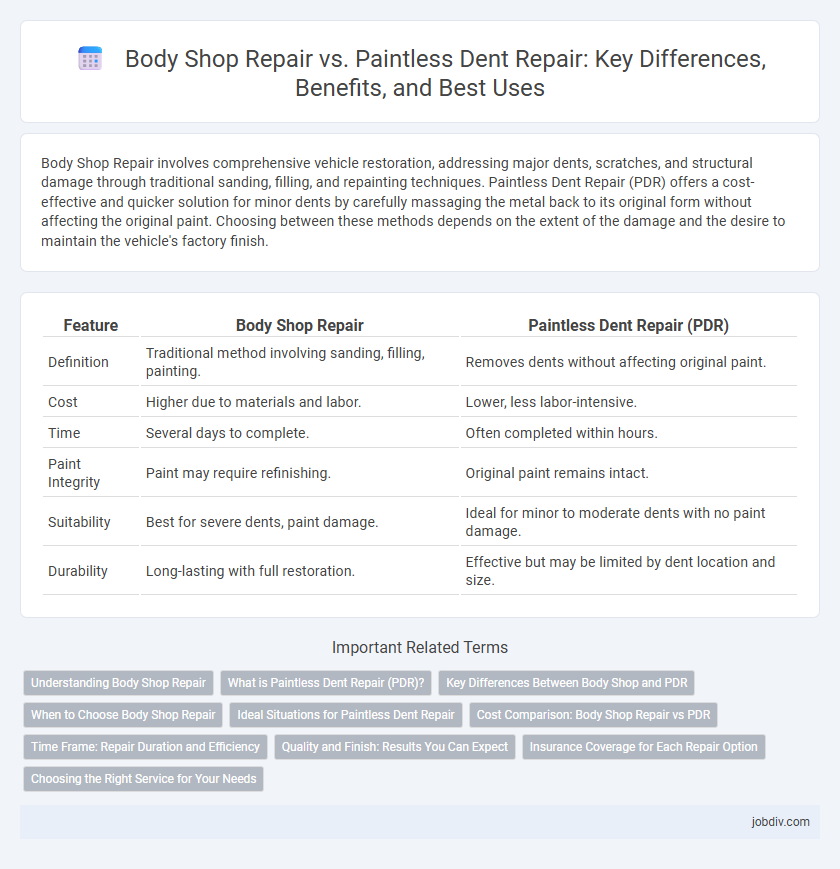Body Shop Repair involves comprehensive vehicle restoration, addressing major dents, scratches, and structural damage through traditional sanding, filling, and repainting techniques. Paintless Dent Repair (PDR) offers a cost-effective and quicker solution for minor dents by carefully massaging the metal back to its original form without affecting the original paint. Choosing between these methods depends on the extent of the damage and the desire to maintain the vehicle's factory finish.
Table of Comparison
| Feature | Body Shop Repair | Paintless Dent Repair (PDR) |
|---|---|---|
| Definition | Traditional method involving sanding, filling, painting. | Removes dents without affecting original paint. |
| Cost | Higher due to materials and labor. | Lower, less labor-intensive. |
| Time | Several days to complete. | Often completed within hours. |
| Paint Integrity | Paint may require refinishing. | Original paint remains intact. |
| Suitability | Best for severe dents, paint damage. | Ideal for minor to moderate dents with no paint damage. |
| Durability | Long-lasting with full restoration. | Effective but may be limited by dent location and size. |
Understanding Body Shop Repair
Body shop repair involves comprehensive restoration of vehicle damage, including frame straightening, replacing parts, and repainting to match factory finishes. This process is ideal for extensive dents, scratches, or collision damage that affects the car's structural integrity. Unlike paintless dent repair, body shop repair addresses underlying issues by using fillers, sanding, and multiple layers of paint to ensure durability and visual consistency.
What is Paintless Dent Repair (PDR)?
Paintless Dent Repair (PDR) is a specialized auto body repair method that removes minor dents and dings without damaging the vehicle's original paint. This technique involves using precise tools to gently massage and reshape the metal from behind the dent, preserving the factory finish and reducing repair time. PDR is highly effective for hail damage, door dings, and small creases where the paint remains intact.
Key Differences Between Body Shop and PDR
Body Shop Repair involves traditional methods such as sanding, filling, and repainting damaged vehicle surfaces, making it ideal for extensive damage including broken panels and deep scratches. Paintless Dent Repair (PDR) uses specialized tools to gently massage dents from the metal without affecting the paint, best suited for minor dents and hail damage where the paint remains intact. The key differences include repair techniques, cost, repair time, and the extent of damage suitable for each method, with PDR generally offering a faster, cost-effective solution preserving the original paint.
When to Choose Body Shop Repair
Body shop repair is ideal for extensive damage involving broken parts, deep scratches, or severe dents where structural integrity is compromised, requiring professional replacement or repainting. Choose body shop repair when the paint is visibly cracked or peeling, as paintless dent repair cannot restore original paint quality or match color perfectly. Complex collisions involving frame damage or multiple damaged panels necessitate body shop expertise to ensure safety and aesthetic restoration.
Ideal Situations for Paintless Dent Repair
Paintless Dent Repair (PDR) is ideal for minor dents and dings where the vehicle's paint remains intact, such as hail damage, door dings, and small creases. This method preserves the original paint finish, making it a cost-effective and quicker solution compared to traditional body shop repair. PDR works best on newer vehicles with flexible metal panels, avoiding the need for repainting or extensive body filler.
Cost Comparison: Body Shop Repair vs PDR
Body shop repair for dents typically costs between $500 and $1500, depending on the damage severity and labor intensity, while paintless dent repair (PDR) usually ranges from $75 to $250 per dent, offering a more affordable option for minor dents without paint damage. Body shop repair involves sanding, filling, and repainting, which increases material and labor costs, whereas PDR uses specialized tools to massage dents from the inside, significantly reducing expenses and repair time. Insurance claims often favor body shop repairs due to comprehensive restoration, but PDR remains cost-effective for small, shallow dents where factory paint remains intact.
Time Frame: Repair Duration and Efficiency
Body shop repair typically requires several days to weeks due to extensive sanding, painting, and curing processes, impacting overall vehicle downtime. Paintless dent repair (PDR) offers a faster alternative, often completing minor dent removal within a few hours without compromising the original paint finish. Choosing PDR can significantly reduce repair duration and improve efficiency, especially for small to medium-sized dents.
Quality and Finish: Results You Can Expect
Body shop repair typically offers comprehensive restoration with high-quality finishes, including repainting and panel replacement, ensuring the vehicle looks as good as new. Paintless dent repair preserves the original factory paint and provides a seamless, blemish-free finish ideal for minor dents, maintaining the car's value. Choosing between the two depends on the extent of damage and the desired level of quality and finish.
Insurance Coverage for Each Repair Option
Insurance coverage for body shop repair typically includes comprehensive claims for collision, vandalism, and severe damage, often covering parts, labor, and paint restoration. Paintless dent repair (PDR) is usually covered when the damage is minor, like hail or small dents, and tends to be a cost-effective option with quicker claim processing. Understanding policy specifics and deductibles is crucial, as some insurers favor PDR for minor repairs due to lower costs and faster turnarounds, while others may require body shop repairs for substantial damage.
Choosing the Right Service for Your Needs
Body shop repair offers comprehensive solutions for extensive damage, including panel replacement, repainting, and frame straightening, ideal for severe dents and scratches. Paintless dent repair (PDR) is a cost-effective method that maintains original paint, perfectly suited for minor dents and dings without compromising the vehicle's finish. Selecting the right service depends on damage severity, budget, and desired turnaround time, ensuring optimal restoration and value retention.
Body Shop Repair vs Paintless Dent Repair Infographic

 jobdiv.com
jobdiv.com